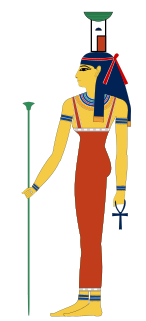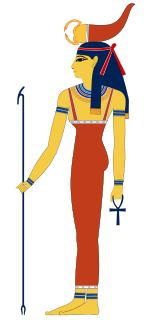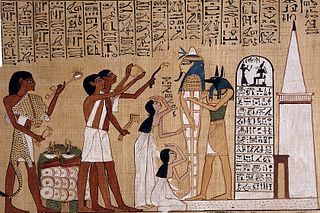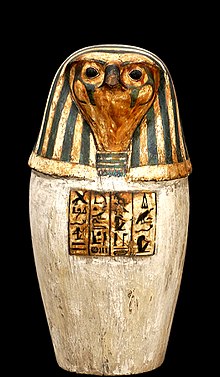
Osiris is the god of fertility, agriculture, the afterlife, the dead, resurrection, life, and vegetation in ancient Egyptian religion. He was classically depicted as a green-skinned deity with a pharaoh's beard, partially mummy-wrapped at the legs, wearing a distinctive atef crown, and holding a symbolic crook and flail. He was one of the first to be associated with the mummy wrap. When his brother, Set cut him up into pieces after killing him, Osiris' wife Isis found all the pieces and wrapped his body up, enabling him to return to life. Osiris was widely worshipped until the decline of ancient Egyptian religion during the rise of Christianity in the Roman Empire.

Hapi, sometimes transliterated as Hapy, is one of the four sons of Horus in ancient Egyptian religion, depicted in funerary literature as protecting the throne of Osiris in the Underworld. Hapi was the son of Heru-ur and Isis or Serqet. He is not to be confused with another god of the same name. He is commonly depicted with the head of a hamadryas baboon, and is tasked with protecting the lungs of the deceased, hence the common depiction of a hamadryas baboon head sculpted as the lid of the canopic jar that held the lungs. Hapi is in turn protected by the goddess Nephthys. When his image appears on the side of a coffin, he is usually aligned with the side intended to face north. When embalming practices changed during the Third Intermediate Period and the mummified organs were placed back inside the body, an amulet of Hapi would be included in the body cavity.

Horus or Heru, Hor, Har in Ancient Egyptian, is one of the most significant ancient Egyptian deities who served many functions, most notably as god of kingship and the sky. He was worshipped from at least the late prehistoric Egypt until the Ptolemaic Kingdom and Roman Egypt. Different forms of Horus are recorded in history, and these are treated as distinct gods by Egyptologists. These various forms may be different manifestations of the same multi-layered deity in which certain attributes or syncretic relationships are emphasized, not necessarily in opposition but complementary to one another, consistent with how the Ancient Egyptians viewed the multiple facets of reality. He was most often depicted as a falcon, most likely a lanner falcon or peregrine falcon, or as a man with a falcon head.

The Osiris myth is the most elaborate and influential story in ancient Egyptian mythology. It concerns the murder of the god Osiris, a primeval king of Egypt, and its consequences. Osiris's murderer, his brother Set, usurps his throne. Meanwhile, Osiris's wife Isis restores her husband's body, allowing him to posthumously conceive their son, Horus. The remainder of the story focuses on Horus, the product of the union of Isis and Osiris, who is at first a vulnerable child protected by his mother and then becomes Set's rival for the throne. Their often violent conflict ends with Horus's triumph, which restores maat to Egypt after Set's unrighteous reign and completes the process of Osiris's resurrection.

Set is a god of deserts, storms, disorder, violence, and foreigners in ancient Egyptian religion. In Ancient Greek, the god's name is given as Sēth (Σήθ). Set had a positive role where he accompanies Ra on his barque to repel Apep, the serpent of Chaos. Set had a vital role as a reconciled combatant. He was lord of the Red Land, where he was the balance to Horus' role as lord of the Black Land.

Nut, also known by various other transcriptions, is the goddess of the sky, stars, cosmos, mothers, astronomy, and the universe in the ancient Egyptian religion. She was seen as a star-covered nude woman arching over the Earth, or as a cow. She was depicted wearing the water-pot sign (nw) that identifies her.

Nephthys or Nebet-Het in ancient Egyptian was a goddess in ancient Egyptian religion. A member of the Great Ennead of Heliopolis in Egyptian mythology, she was a daughter of Nut and Geb. Nephthys was typically paired with her sister Isis in funerary rites because of their role as protectors of the mummy and the god Osiris and as the sister-wife of Set.

Serket is the goddess of healing venomous stings and bites in Egyptian mythology, originally the deification of the scorpion. Her family life is unknown, but she is sometimes credited as the daughter of Neith and Khnum, making her a sister to Sobek and Apep.
Sobek was an ancient Egyptian deity with a complex and elastic history and nature. He is associated with the Nile crocodile or the West African crocodile and is represented either in its form or as a human with a crocodile head. Sobek was also associated with pharaonic power, fertility, and military prowess, but served additionally as a protective deity with apotropaic qualities, invoked especially for protection against the dangers presented by the Nile. Sobek has been famed for having been revered by the first female Pharaoh by the Nebty name Sat-Sekhem-Nebet-Tawy Sobekneferu, present both in the female Pharaoh's nomen, Sobek'Neferu, and her praenomen Ka'Sobek'Re.
Duamutef was, in ancient Egyptian religion, one of the four sons of Horus and a protection god of the canopic jars. Commonly he is said to be the son of the god Horus the Elder. Another myth describes Duamutef and his brothers as sons of Osiris. According to this account, they were born from a lily flower which arose from the primaeval ocean.

The ancient Egyptians believed that a soul was made up of many parts. In addition to these components of the soul, there was the human body.

Canopic jars are containers that were used by the ancient Egyptians during the mummification process, to store and preserve the viscera of their owner for the afterlife. They were commonly either carved from limestone, or were made of pottery. These jars were used by the ancient Egyptians from the time of the Old Kingdom, until the time of the Late Period or the Ptolemaic Period, by which time the viscera were simply wrapped and placed with the body. The viscera were not kept in a single canopic jar: each jar was reserved for specific organs. The term canopic reflects the mistaken association by early Egyptologists with the Greek legend of Canopus – the boat captain of Menelaus on the voyage to Troy – "who was buried at Canopus in the Delta where he was worshipped in the form of a jar". In alternative versions, the name derives from the location Canopus in the western Nile Delta near Alexandria, where human-headed jars were worshipped as personifications of the god Osiris.

The Eye of Horus, wedjat eye or udjat eye is a concept and symbol in ancient Egyptian religion that represents well-being, healing, and protection. It derives from the mythical conflict between the god Horus with his rival Set, in which Set tore out or destroyed one or both of Horus's eyes and the eye was subsequently healed or returned to Horus with the assistance of another deity, such as Thoth. Horus subsequently offered the eye to his deceased father Osiris, and its revitalizing power sustained Osiris in the afterlife. The Eye of Horus was thus equated with funerary offerings, as well as with all the offerings given to deities in temple ritual. It could also represent other concepts, such as the moon, whose waxing and waning was likened to the injury and restoration of the eye.

The ancient Egyptians had an elaborate set of funerary practices that they believed were necessary to ensure their immortality after death. These rituals included mummifying the body, casting magic spells, and burials with specific grave goods thought to be needed in the afterlife.

The four sons of Horus were a group of four gods in ancient Egyptian religion, who were essentially the personifications of the four canopic jars, which accompanied mummified bodies. Since the heart was thought to embody the soul, it was left inside the body. The brain was thought only to be the origin of mucus, so it was reduced to liquid, removed with metal hooks, and discarded. This left the stomach, liver, large intestines, and lungs, which were removed, embalmed and stored, each organ in its own jar. There were times when embalmers deviated from this scheme: during the 21st Dynasty they embalmed and wrapped the viscera and returned them to the body, while the canopic jars remained empty symbols.

Canopic chests are cases used by ancient Egyptians to contain the internal organs removed during the process of mummification. Once canopic jars began to be used in the late Fourth Dynasty, the jars were placed within canopic chests. Although the first proven canopic burials date from the Fourth Dynasty reign of Sneferu, there is evidence to suggest that there were canopic installations at Saqqara dating from the Second Dynasty.

The Weres was an amulet that symbolically represented the pillow or headrest under the head of an Egyptian mummy. They were placed under the mummy's head to protect it from damage. The Weres amulet was often inscribed with a spell which read: "Their enemies have no power to cut off the heads of the deceased. The deceased shall cut off the heads of their enemies." Weres amulets were sometimes placed in mummy wrappings to magically protect and lift the head of the deceased.

The Serapeum of Saqqara was the ancient Egyptian burial place for sacred bulls of the Apis cult at Memphis. It was believed that the bulls were incarnations of the god Ptah, which would become immortal after death as Osiris-Apis. a name which evolved to Userhapi (ⲟⲩⲥⲉⲣϩⲁⲡⲓ) in Coptic, and Serapis (Σέραπις), in the Hellenistic period.

















